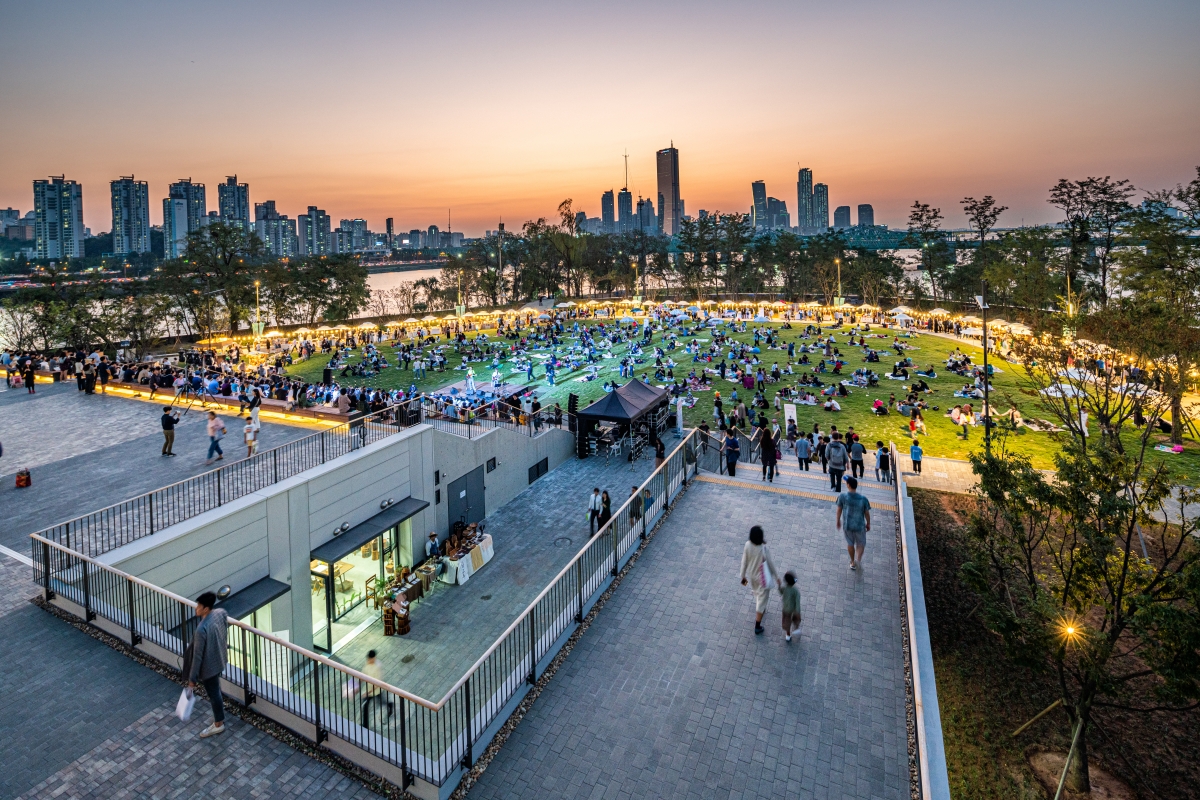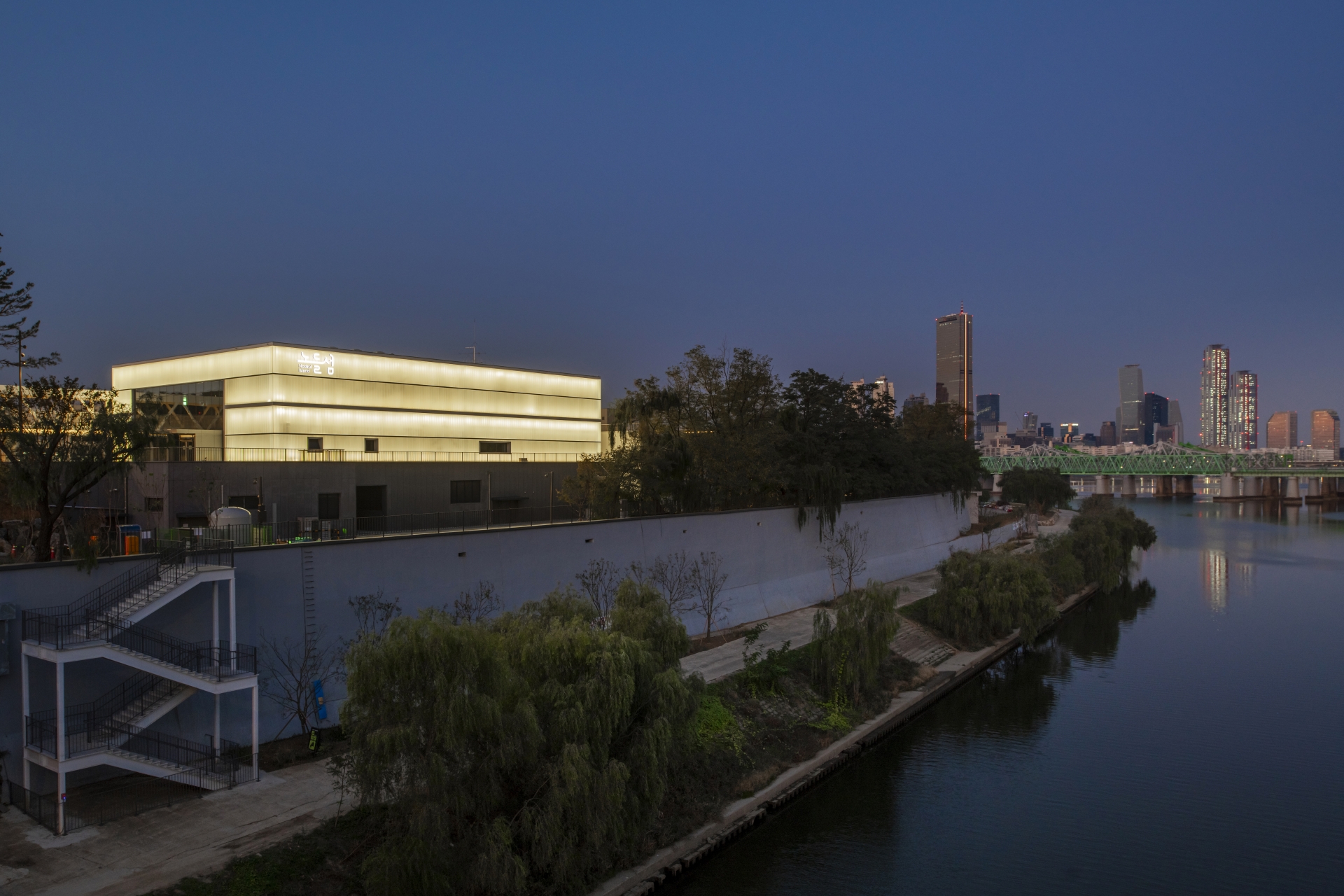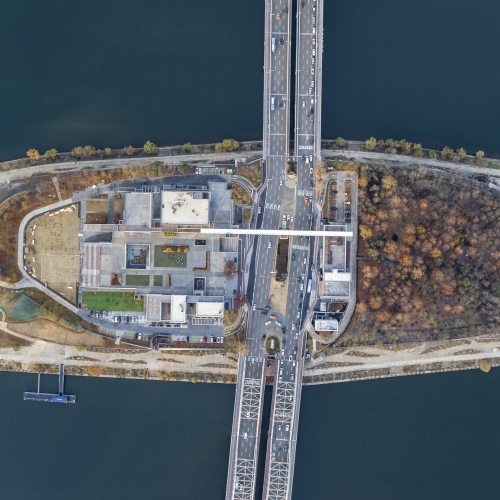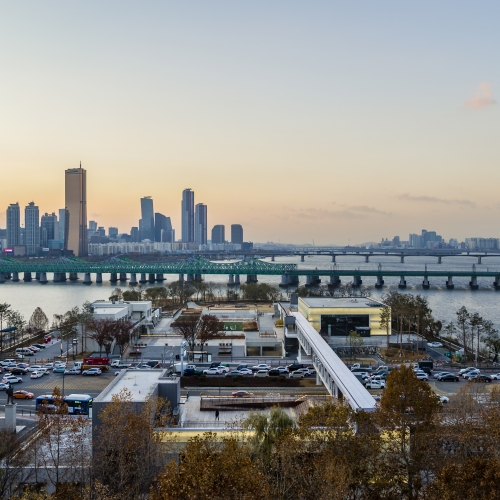Value Reified by Fetishism
When trying to understand the meaning and value of an object, it is very useful to look at it in terms of its social context. This is the case when inspecting the project of Nodeul Island. Apart from the recent controversies about the symbolic nature and aesthetics of its architecture, a more prominent set of problems regarding the public development of the reserved common area can be defined through the two issues that arose at the completion of the project. They are 1) the government’s immature understanding of the commons and 2) the undemocratic administration of decision making among stakeholders engaged in the development. Additionally, the competition win of the operating authority was revoked; and as it is impossible to appoint the facility operator under the administrative regulations, the project seemingly returned to the conventional—implementing an architectural design competition first and relying on the system of a private trust that grants a restricted right of operation. Such series of trial and error are a common reality resulting from the rigidity of a system failing to accommodate citizens’ desire. Then what would have been a desirable direction for the inculturation of the land and reconfiguring it as a territory for citizens? Rather than personalising each different viewpoint and aspiration, it would have been better to secure the island as a common ground in which all members of society could build and share their hopes together. This would also have been a matter of protecting the island as reserved land for the future dedicated to everyone in the Megapolis, Seoul which is dominated by capital.
Let me ask a question: ‘why did a semi-permanent building have to be constructed on that land?’ The initial approach of the project ‘Nodeul Dream Island’ seemed to propose a new architectural grammar when handling space and time. There has been an effort to incorporate free and new ways of life – which emerged in the blurring boundaries between work and play – to the project. This was feasible without constructing an actual building. The project was an attempt to challenge the conventional distinctions and ways of understanding behaviour in urban public places, such as attitudes to space and place; scenery and surrounding; public and private things; and culture and life. It also raised citizens’ chances of enjoying cultural needs, in addition to the ideas and cultural imagination of novel spatial planning. It was pioneering way of changing the thinking on the subject, suggesting an operation must precede the construction of space. However, that was the end. The engine halted and went back to the accustomed method of operation. Then, before our eyes, artificial structures – added on top of the layers of nature – unfolded like an unfamiliar landscape. In the island, there are longstanding relationships between nature and time, city and culture, which are so closely intertwined. Before embarking on construction, therefore, it was necessary to form a consensus on how the boundary conditions inherent to the indigenous loci on the island could be adjusted sensitively. Prior to the inculturation of our contemporary desires, the validity of breaking down boundaries should have been verified first. Moreover, the social ethics of constructing structures on the island should have been more carefully contemplated and assessed.
In modern society, values are always reified with a fetishistic intensity. The Nodeul Island was no exception. Its value as common ground instantly became reified as the rigidity of bureaucracy intervened. The Operation Director of the Nodeul Island, Bin Kim (professor, University of Seoul) once said in an interview: ‘A single day of voluntary drifting. As you get away from your daily life and continues to drift, a place where you suddenly arrive and discover unexpected pleasures: that is the Nodeul Island’. As in this phrase, keywords highlighting the way in which the structure which was involved in the inculturation of the island are ‘citizen’, ‘daily life’, ‘culture and art’, and ‘voluntariness and democracy’. The intention behind constructing buildings on the land was to give greater sense of space to the public plan that recognised citizens’ desire to enjoy culture and art. However, this method of spatialised structure resulted in a scenery far removed from the citizens’ hopes for an ecological island of culture. It was not a real nor was it an imaginary space; rather than becoming a space in which one could drift away from daily life, it became an ephemeral space of consumption that must be visited with a purpose. As a result, there was a rift between the citizens’ desire to enjoy culture and the space as a vessel that embodies it.
The Present Condition: Physical Landscape has Become Dominant
Are the changes to Nodeul Island agreeable? To answer this question, it might be more valid to raise up the following question: was ‘Spatial Justice’ fulfilled as a relation between the commons – the island – and the citizens who had exclusive rights to use that space? Nodeul Island was supposed to offer a new plaza that constantly reproduces cultural discourses on rest and play in the society, and that plaza should have been a stage for everyday life where any urban dweller can become a leading actor.
At this moment, it is too hasty to properly evaluate the project—whether the cultural impoverishment and fragmentation of urban dwellings could be recovered through the plaza of daily life, which constructs new definitions of commonality and collectivity, or whether Nodeul Island has transformed a sense of the commons as a space where ‘a single day of voluntary drifting is possible’. Yet it is doubtful whether the Nodeul Island has various spatial languages that imply the potentials for change. The recent controversy over the buildings has been due to the fact that the overall design did not show the indigenous nature of the place that the land has, that is, the aesthetics of difference through the specific method of construction.
Constructing the issue of public value as a factor in specific experience on Nodeul Island depends upon a cultural attitude that respects and reproduces the value of ‘placeness’, and also upon the integration of space and operation. Nevertheless, the reality of the island that we encountered was as follows: the physical form of buildings rapidly became the dominant content. All the effort of reading time and place, space and structure, power and interest, and interpreting these aspects as forming a territory of culture was replaced with an overly simplified form, losing a more diverse cultural interpretation.
Nodeul Island is a place that could celebrate a sense of time that we no longer remember. However, there is something lacking in buildings that reproduce the cultural imagination that we dreamed of on the island: there is no spatial consideration of what we should never lose on the island, and on how the artificial intervention into the land can contemporise the memories of that place and give life to the value of existence. At this time, when it is already territorialised and moved on to the stage of operation, the process of culturally reconstructing Nodeul Island depends upon how to convert an inflexible structure that is inherent to the space into a looser form of flexibility through operation. It also depends on how to reconfigure it into a cultural and spatial language that can communicate with civic society.
Rights to the Commons in Urban Space
Whenever the government discusses the potential of using the commons, it says that the administration is always with the citizens. But when it comes to practicing specific administrative power, the government puts its own standards down that civic society cannot fully grasp. The value that is supposedly dedicated to the citizens just becomes a good-looking but deceptive proposition for the forefront, and administrative opportunism under that cause will probably become the actual standard. So, citizens always question whether ‘we are walking the same path’.
Strictly speaking, the government-owned public assets, such as the Nodeul Island, are civic assets. How can we correct the government’s errors in decision-making, where civic participation – which has become relatively active than how it was in the past – does not lead to practical process of decision making, and where the government considers public assets to be owned by the public, that is, the government, and unilaterally decides on the purpose of their usage? It is the same whether the principal-agent is the government of Seoul or a public institution. During the process of deciding the most appropriate use of the commons between the government and civil society, the government-oriented monopoly of power is intensified. Since it is not an imbalance produced by the empowerment of civil society, it must lie with the administration which must now be seriously recast. It is necessary to have a frame shift in the administrative system which could ultimately emphasise autonomy in civil society.
The conflict between the government and civil society – the former who tries to monopolise the right to decision-making on the use and disposal of common assets, and the latter who aims to secure the rights to claim autonomous operations – must ultimately be resolved through the promotion of human rights in the urban space. Ensuring the autonomy of civil society over the commons is linked to the idea in which the right to the city is a human right. Ensuring the autonomy of the commons is the basic principal to promote human rights in the urban space. Securing the commons through society’s autonomous management of common assets will not take place in a flash, nor will it occur simply through the discussion of Nodeul Island. In order to extend the range of the autonomy in civil society from within the framework of institutionalised administrative power, first, it is necessary for citizens to recognise their rights and to obtain a certain freedom of communication that will prioritise the value of the community from within the government.
The Humanistic Spatial Values of the Local and the Aesthetics of Difference
The strategy of organising a spatial system for cultural reproduction – in which life and space; the local and society; and the city and the economy can be in constant circulation with culture – can be largely divided into three sequences. The primary cycle is the establishment of institutional cultural space by the public sectors who intervene in the cultural space. The secondary cycle is the de-institutionalisation and de-politicisation of cultural space by the local governance. The tertiary cycle can be seen as the stage at which the reproduction of cultural space is made feasible through the empowerment of the civil society in which various groups discuss. Nodeul Island has now entered the transitional phase from the primary cycle to the secondary cycle. An error that commonly occurs in this process is as follows: the project begins with good intentions to promote cultural value, but during the process of conceptualisation, institutionalisation, and commercialisation, the government naturally attains authority, adding rigidity in the business. As a result, it becomes difficult to form an autonomous cultural plan in the private sector, in which a citizen becomes the principalagent and continuously reproduces rich cultural content in daily life. This right away leads to the issue of cultural sovereignty through the commons. In order for Nodeul Island to secure the individual identity as a single territory and cultural diversity and to obtain cultural sovereignty, what are the things that we need?
In the case of Nodeul Island, the government’s distorted perception and conceptualisation of the commons was combined with the form of business, exposing a crisis of restricting and distorting the infinite potential of culture. There is an inherent desire to recognise culture as a single object or world of matters, and to place restrictions on it. We usually take this attitude because it makes it easier to configure culture as a sphere that can be manipulated. That desire eventually creates cultural supremacy. As a result, a near-blind political optimism, which believed that culture would solve the problems inherent to the subject, issued a non-cultural prescription entitled Nodeul Island.
Whether we dream of another future by channeling culture or we repeat the past depends on how we promote civil society as a cultural agent. How to maximise the sensibilities of civil society, namely energy of the free spirit through culture is based on how much we will allow the continuous operation of the space known as Nodeul Island and the autonomy of the operating entity to the private sector—the public and the third party that represents civil society. At last, space can become free, once it escapes from the government’s unilateral authority that controls the space. Nodeul Island can set out a new future for urban space, when individual citizens can enjoy the aesthetics of difference – that is a space distinguished from other cities’ sense of place – and the culture of daily life in Nodeul Island—the place that no longer functions as an institution or a programmed culture.

©Yu Cheong O







